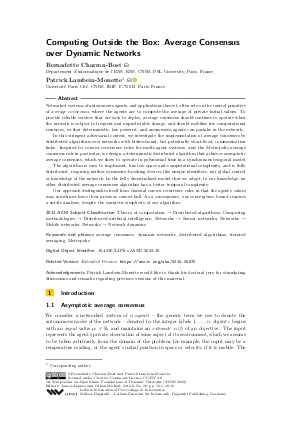@InProceedings{charronbost_et_al:LIPIcs.SAND.2022.10,
author = {Charron-Bost, Bernadette and Lambein-Monette, Patrick},
title = {{Computing Outside the Box: Average Consensus over Dynamic Networks}},
booktitle = {1st Symposium on Algorithmic Foundations of Dynamic Networks (SAND 2022)},
pages = {10:1--10:16},
series = {Leibniz International Proceedings in Informatics (LIPIcs)},
ISBN = {978-3-95977-224-2},
ISSN = {1868-8969},
year = {2022},
volume = {221},
editor = {Aspnes, James and Michail, Othon},
publisher = {Schloss Dagstuhl -- Leibniz-Zentrum f{\"u}r Informatik},
address = {Dagstuhl, Germany},
URL = {https://drops-dev.dagstuhl.de/entities/document/10.4230/LIPIcs.SAND.2022.10},
URN = {urn:nbn:de:0030-drops-159521},
doi = {10.4230/LIPIcs.SAND.2022.10},
annote = {Keywords: average consensus, dynamic networks, distributed algorithms, iterated averaging, Metropolis}
}

 Creative Commons Attribution 4.0 International license
Creative Commons Attribution 4.0 International license
